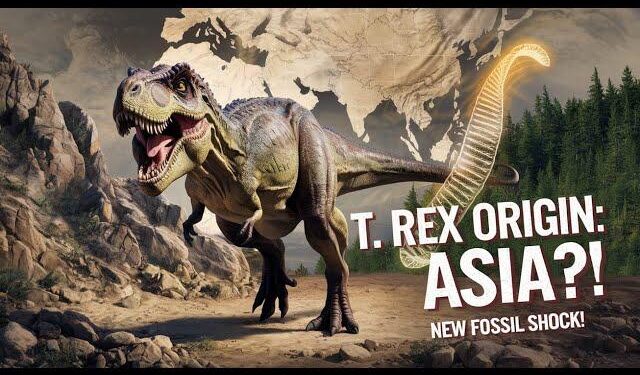In a groundbreaking development that promises to reshape our understanding of one of history’s most formidable predators, scientists are making significant strides in unraveling the enigmatic origins of Tyrannosaurus rex. Recent research, as reported by Live Science, sheds light on the evolutionary lineage of this iconic dinosaur, providing new insights into how it emerged as a dominant force during the Late Cretaceous period. This exciting revelation not only deepens our knowledge of T. rex but also enhances our overall comprehension of dinosaur evolution and biodiversity. As researchers piece together the puzzle of how T. rex fits into the greater tapestry of prehistoric life, the findings could have far-reaching implications for paleontology and our understanding of the prehistoric world.
Unraveling the Genetic Tapestry of T. rex Ancestry
Recent advancements in paleogenomics are shedding light on the intricate lineage of Tyrannosaurus rex, challenging long-held beliefs about its origin and evolution. Researchers used advanced DNA sequencing techniques to analyze fossilized remains, revealing clues about its relationships with other theropod dinosaurs. This groundbreaking work suggests that T. rex may share a closer ancestry with smaller, feathered dinosaurs than previously thought, prompting a reevaluation of its place in the dinosaur family tree. The discovery adds a new layer of complexity to the evolution of these majestic creatures, illustrating how the genetic tapestry of the past is woven together.
Key findings from the study include:
- Genetic links: Evidence of shared genes with smaller theropods.
- Evolutionary timeline: Insights into the divergence of T. rex from its ancestors.
- Adaptations: The role of feather-like integument in early forms of T. rex.
To summarize the key relationships unveiled by recent analyses, the following table illustrates the evolutionary connections between T. rex and its closest relatives:
| Species | Relationship | Shared Traits |
|---|---|---|
| T. rex | Direct descendant | Large size, powerful bite |
| Velociraptor | Close relative | Feathered body, agility |
| Allosaurus | Remote ancestor | Predatory adaptations |
Key Discoveries from Fossil Evidence Enhance Understanding of Theropod Evolution
Recent fossil discoveries have shed significant light on the evolutionary journey of theropods, especially concerning their lineage leading to iconic species like Tyrannosaurus rex. Among the pivotal findings are remarkably preserved specimens that show a spectrum of physical traits bridging earlier and more advanced theropods. These fossils display characteristics such as:
- Feathered appendages: Evidence of protofeathers on smaller theropods, suggesting a developmental link to modern birds.
- Variation in limb structures: Discoveries of transitional limb morphology hint at evolutionary adaptations for different predatory strategies.
- Changes in size and dentition: Fossil records reveal a gradual increase in body size alongside modifications in tooth shapes, indicating shifts in dietary preferences.
Furthermore, advanced imaging techniques, such as CT scans and 3D reconstruction, have allowed paleontologists to decode internal structures and trace evolutionary changes more effectively. A notable specimen, the Yutyrannus huali, exhibits both size and feathering, presenting a compelling case for the relationship between flight and predation evolutions in theropods. The findings clarify the timeline of key adaptations, as illustrated in the table below:
| Adaptation | Approximate Timeframe | Significance |
|---|---|---|
| Feather Development | 150 million years ago | Baseline for avian characteristics in theropods |
| Increased Size | 130 million years ago | Shift towards apex predator roles |
| Dental Changes | 75 million years ago | Shift from herbivorous to carnivorous diets |
Implications for Paleontology and Future Research Directions on Dinosaur Lineage
Recent advances in the study of Tyrannosaurus rex origin are poised to significantly influence paleontological methodologies and our understanding of dinosaur lineage. Researchers have utilized cutting-edge techniques such as phylogenomic analyses and advanced imaging technologies to uncover relationships that may have been previously obscured. As scientists narrow down the most closely related species to T. rex, we could see a paradigm shift in how we interpret evolutionary pathways, leading to a re-evaluation of existing hypotheses about theropod evolution and diversification. This could, in turn, redefine our conceptualization of the ecological roles that these giants played in their environments.
The implications of this research extend beyond T. rex and challenge us to consider broader patterns in dinosaur evolution. Future research could focus on several key areas, including:
- Comparative anatomy of newly identified relatives.
- Paleoenvironments that supported early theropods.
- Evolutionary adaptations in response to changing climatic conditions.
To better organize these emerging findings, future studies may benefit from collaborative databases that track morphological and genetic data of dinosaur species across different time periods. This holistic approach could enhance our understanding of evolutionary trends and the life history of these magnificent creatures.
Insights and Conclusions
As researchers continue to unravel the complex lineage of one of the most iconic dinosaurs, the insights gained from recent studies not only shed light on the origin of Tyrannosaurus rex, but also enhance our understanding of dinosaur evolution as a whole. With advanced techniques in genetics, paleontology, and comparative anatomy, scientists are piecing together a more comprehensive picture of how these magnificent creatures evolved over millions of years. While questions remain, the progress made indicates that we are on the cusp of significant breakthroughs in paleobiology. As the scientific community eagerly awaits further discoveries, the legacy of T. rex serves as a vivid reminder of the ever-evolving story of life on Earth. Stay tuned to Live Science for the latest updates on this captivating field of research.































